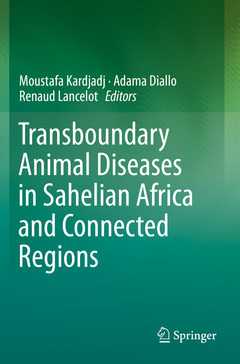Description
Transboundary Animal Diseases in Sahelian Africa and Connected Regions, 1st ed. 2019
Language: English
Subjects for Transboundary Animal Diseases in Sahelian Africa and...:
Keywords
transboundary animal diseases; African Sahel region; animal health; epidemiology; livestock production; emerging disease management; zoonoses; rabies; brucellosis; avian influenza; Foot-and-mouth disease; bluetongue virus; capripoxvirus; Newcastle disease; swine fever; Rift Valley fever; equine encephalitis virus; infectious diseases
Publication date: 12-2020
484 p. · 15.5x23.5 cm · Paperback
Publication date: 12-2019
484 p. · 15.5x23.5 cm · Hardback
Description
/li>Contents
/li>Biography
/li>Comment
/li>
This book primarily focuses on the African Sahel region, shedding new light on the epidemiology, socio-economics, clinical manifestations and control approaches of transboundary animal diseases (TADs) in this specific region. In addition to the description of TADs in Sahelian Africa and connected regions, several issues regarding the burden of TADs, the role of national/regional/international veterinary organizations in the surveillance process, animal mobility, one health and TADs in the dromedary are discussed.
The book contains 22 chapters and is structured in three parts, i- general features and commonalities, ii- viral diseases, iii- bacterial diseases. Each chapter was written by a group of experts specialized in the topic. This work will be of general interest to researchers, veterinarians, veterinary public health officers, and students engaged in the surveillance and control of animal infectious diseases, included those of zoonotic nature and that are prevalent in the Sahel.
Part 1 - General features and commonalities.- Chapter 01 : The Sahelian region: characteristics and challenges (Moustafa Kardjadj, Algeria).- Chapter 02: The burden of transboundary animal diseases (Jonathan Rushton, Bruce Mieghan, UK).- Chapter 03 : TADs and global changes (Matthew Baylis, UK).- Chapter 04 : TADs and animal mobility (Mark Rweyemamu, South Africa).- Chapter 05 : TADs surveillance and control (including national vet services, regional approach, regional and international organizations, GF-TADs) (Karim Tounkara, Mali).- Chapter 06 : One Health - Opportunities and challenges (Esther Schelling, Switzerland; Mahamat Fayiz Abakar, Chad).- Chapter 07 : TADs in dromedary (Bernard Faye, France).- Part 2 - Viral diseases.- Chapter 08 : Rabies (Jakob Zinsstag, Monique Lechenne, Switzerland).- Chapter 09 : Rift Valley fever and vectors of RVFV (Renaud Lancelot, France).- Chapter 10: Other mosquito-borne diseases (WNF….) (Assane Gueye Fall, Senegal).- Chapter 11: Ebola and other haemorrhagic fevers (Matthieu Bourgarel, France).- Chapter 12: Foot-and-mouth disease (Tesfaalem T. Sebhatu, USA).- Chapter 13: Peste des petits ruminants (Adama Diallo, France).- Chapter 14: Lumpy skin disease and vectors of LSDV (Esayas Gelaye, Ethiopia).- Chapter 15: Sheep and goat pox (Khalil Zro, Morocco).- Chapter 16: African horse sickness and vectors of AHSV (Javier Castillo-Olivares, Spain).- Chapter 17: Bluetongue and vectors of BTV (Alessio Lorusso, Italy).- Chapter 18: African swine fever (Emmanuel Couacy-Hyman, Cote D’ivoire).- Chapter 19: Avian influenza (Clement Meseko, Nigeria).- Chapter 20: Newcastle disease (Giovani Cattoli, Italy).- Part 3 - Bacterial diseases.- Chapter 21: Brucellosis (Jacques Godfroid, Norway).- Chapter 22: Tuberculosis (Lilian Akudo Okeke, Nigeria).- Chapter 23: Contagious bovine pleuropneumonia (William Amanfu, Ghana).- Chapter 24: Contagious caprine pleuropneumonia (François Thiaucourt, LuciaManso Silvan, France).- Chapter 25: Heartwater and Amblyomma variegatum (Hassane Adakal, Niger).
Dr Moustafa Kardjadj, DVM, MVS, PhD, is a senior scientist at SPA (Santé et Production Animal) research laboratory of ENSV (The Algerian Veterinary School) and an Assistant Professor of statistics / director of studies and diploma of ESSAIA (The Algerian Food Science School). Dr Kardjadj has long-standing experience in field epidemiology in North-African region (Morocco, Algeria, Tunisia, Libya and Egypt). He is a former scientific director of INMV (the Algeria national veterinary laboratories). His current research is focused on describing the epidemiology of animal diseases (TADs, EIDs and Zoonosis) in North African and Sahelian region. At the time of completion of the present work, Dr Kardjadj has published 31 papers in international journals, several book chapters and 78 conference papers.
Dr Adama Diallo, DVM, PhD, is a senior scientist of ASTRE (Animals, Health, Territories, Risks & Environment) research unit of CIRAD (The French agricultural research and international cooperation organization) working currently in Senegal as the advisor of the Director of the Senegal national veterinary laboratory LNERV (Laboratoire National d’Elevage et de Recherches Vétérinaires). Dr Diallo is a recognized expert in vaccine and diagnostic tests development for the control of animal diseases. He is the author of one of the Peste des Petits Ruminants (PPR) live attenuated vaccines currently in use for the PPR control. He is a former head of the virology section in Cirad in Montpellier, France, and a former head of the Animal Production and Health Laboratory at the International Atomic Energy Agency (IAEA) in Vienna, Austria.
Dr Renaud Lancelot, DVM, PhD, is Deputy Director of ASTRE (Animals, Health, Territories, Risks & Environment) research unit of CIRAD (The French agricultural research and international cooperation organization) and INRA (French National Institute for Agricultural Research). He has extensive experience iThese books may interest you

Parasitic Zoonoses 210.99 €



